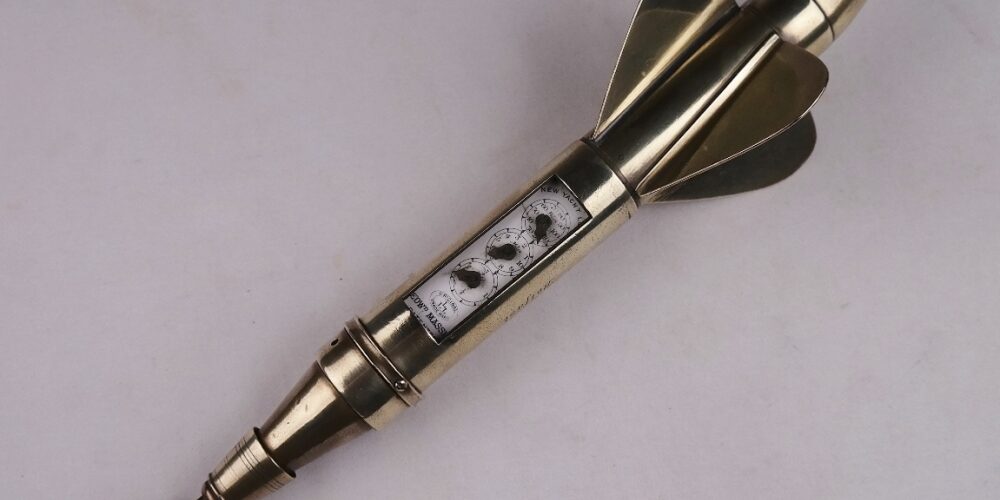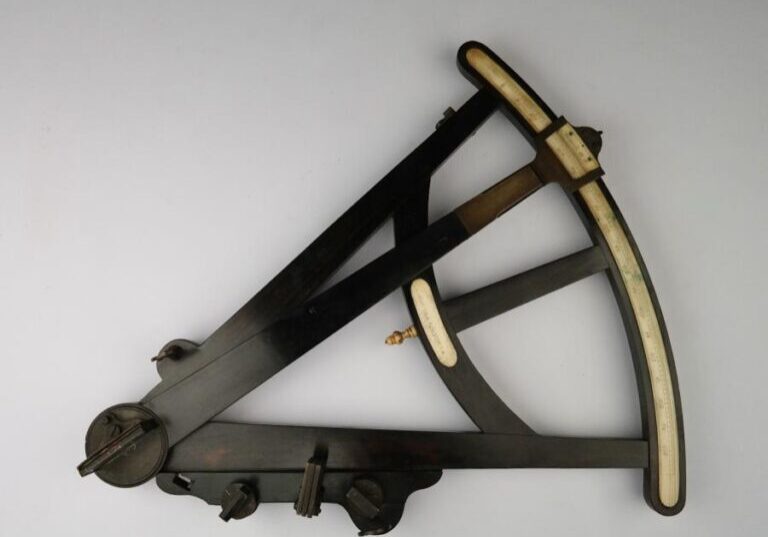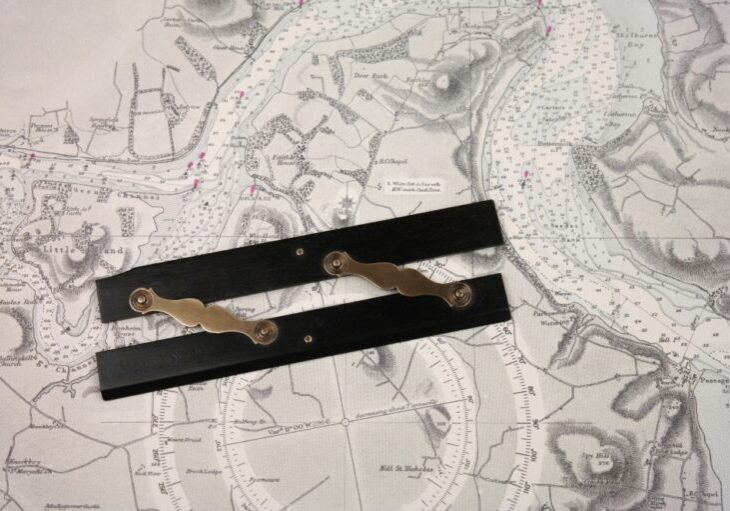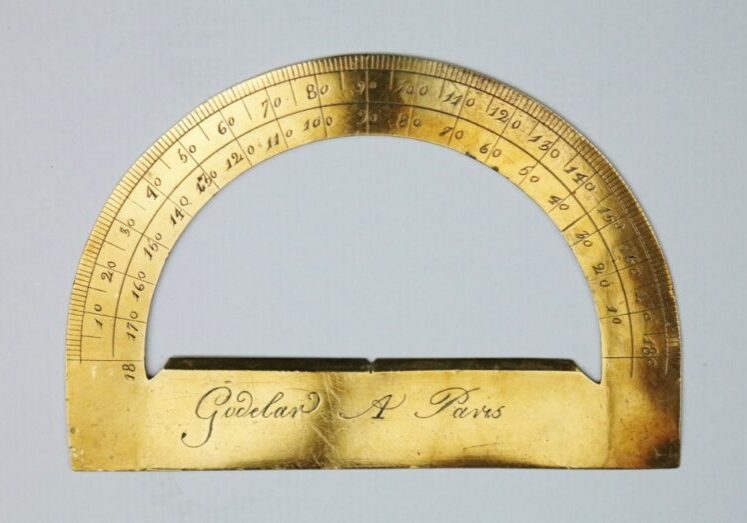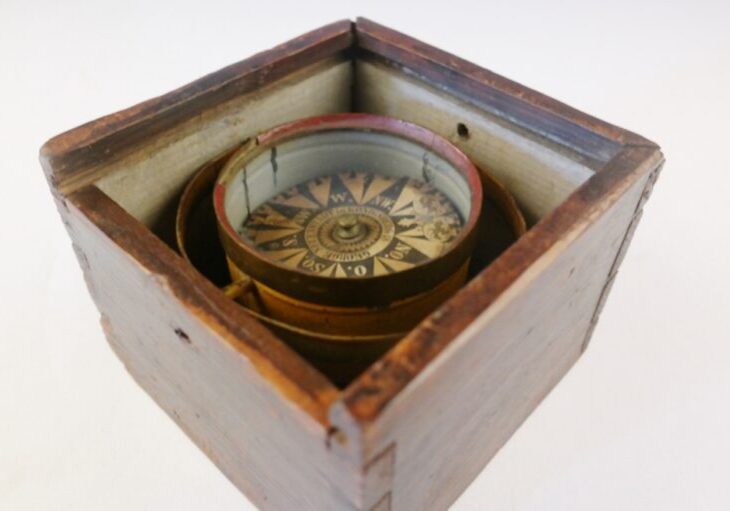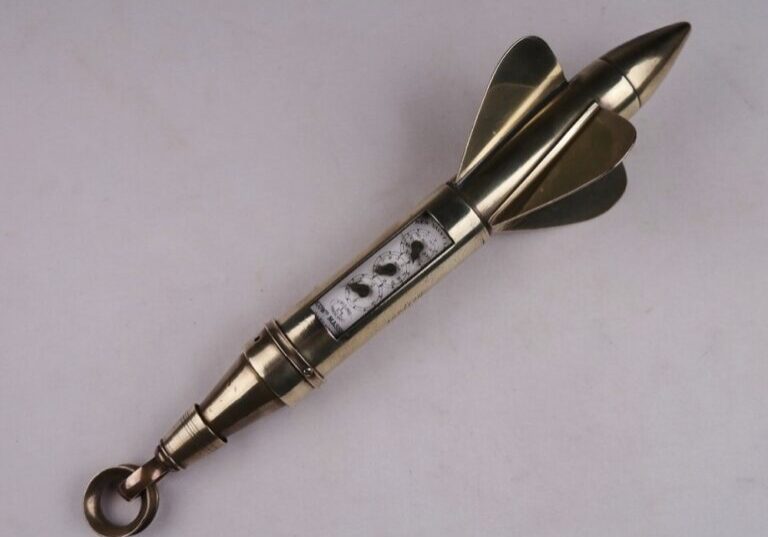Nautical instruments
This part of the collection includes mainly navigational instruments from the early sailing period, the time when ships were made of wood and men were made of steel.
Divider with ball head in fine condition. One of the legs is marked with 62. The other with 41.
Catalog: NM.3-04
Date: 1760 – 1810
L: 13,5 cm (5,3 in)
Signed: not signed
Origin: unknown
Condition: perfect for its age
An early and interesting three mirror octant with Vernier nonius, made by or for S. Williams at Hull in 1767.
The first octant was created by Hadley in 1731. In Great-Britain and North-America the instrument was called the Hadley’s quadrant to distinguish it from the Davis quadrant. Hadley got in 1734 a patent for eleven years. Immediately after it came to an end other instrumentmakers started with making octants.
This octant is an early ebony one. The graduated scale is made of ivory with a Vernier nonius. The engraving is made by hand. At the graduation every degree is divided in parts of 20 minutes. The Vernier nonius is divided in twenty equal parts. The accuracy of reading with this nonius is one minute.
The lower horizon mirror and peepsight were used for backward observation. As the horizon just below the sun was invisible, in this way it was possible to use the opposite horizon. The instrument was used back to front. The observer had the sun in his back. The sunshades moved to the lower position.
This beautiful instrument with nice patin, is complete and in a fine condition, with three mirrors, two peep sights and three sunshades. On the backside three brass legs and the adjusting-screws.
The mirror table of this octant is also made of ebony. Octants of a later date have brass ones. The nonius does not have a double scale anymore but still has the width of a double scale.
Catalog: NM.2-44
Date: 1767
HW: 45,5×38,5 cm (18×15 in)
Radius (rotation axis till nonius): 39,5 cm (15.5 in)
Signed: * S. Williams Hull 1767 *
Origin: England
Condition: very well
Well preserved middle sized, dry card and gimbaled compass in painted wooden case with slit cover. On the rose with 32 points, the name of the maker. North with beautiful fleur de lis. The paint on the dovetailed case is beautifully crackled. The outside of the binnacle is painted black over green. The inside of the binnacle is painted white without a lubber’s line.
Catalog: NM.2-13
Date: 1880-1900
HWL case: 15×21,5×21,5 cm (5,9×8,5×8,5”)
D compass: 14 cm (5,6”)
Signed: F. SMEDING. ENKHUIZEN.
Origin: Netherlands
Condition: perfect with signs of wear
Very small ruler, only 6 inch wide.
Rulers like this one are used to plot course lines and bearings on nautical charts. They can be rolled across the chart to the compass rose without changing its orientation.
Catalog: NM.3-15
Date: 1850-1900
WL: 15,5×3,7 cm (6×1,5 in)
Signed: not signed
Origin: England
Condition: in good working condition, smal angle piece missing
Eigtheen century brass protractor with hand engraved inner and outer scales. Tapered outer edges and beveled straigth edges. The name of the maker engraved in flamboyant style.
Catalog: NM.2-52
Date: 1770-1790
HW: 6,5×9,5 cm
Signed: Godelar A Paris
Origin: France
Condition: excellent
Attractive gimbaled dry card compass in a brass, yellow painted bowl. Wooden case of pine with sliding cover with dirty grey painted inside. Made by Georg Neuenstadt, Koningsberg, Germany (Kalinningrad, Russia). The inside of the bowl also dirty grey with four lubber’s lines.
The rose is made of lackered paper stiffed with mica and another layer of paper, which indicates an early compass. On the underside a strong and heavy needle and a name, difficult to read.
Strong and heavy needles are introduced in 1745 by Gowen Knight.
Catalog: NM.1-39
Date: around 1800
HWL case: 11×15,5×15,5 cm (4 3/8×6 1/8×6 1/8“)
D compass: 9,5 cm (3 4/8”)
Signed: GEORG NEUENSTADT in KONIGSBERG 18
Origin: Germany
Condition: perfect
The parallel ruler is a navigation instrument to set up bearings and course lines in the sea chart.
Catalog: NM.3-02
Date: ca. 1900
WL: 55,5×6,3 cm
Signed: not signed
Origin: unknown
Condition: in good working condition, wear consistent with age and use
Brass divider with steel tips in fine condition.
Catalog: NM.2-38
Date: 1880-1920
L: 20 cm (7,9”)
Signed: not signed
Origin: continental
Condition: in working condition, wear consistent with age and use
On the log, behind a rotary slide there are three dials, the first registers the miles up to 100, the second registers the units up to 10 mile, the third registers quarters of a mile.
On the enamel scale: NEW YACHT LOG – ORIGINAL LLL TRADEMARK – EDWd. MASSEY, LONDON – PATENTEE
In the four rotator blades is stamped a star shaped motif with the letter M.
The log is a scaled down version of the fritionless log which was introduced in 1865. A start date of manufacturing of this yacht log is unknown, but a similar sized and shaped log, called the Conical End Log was being advertised in the Wilson 1877 catalogue. (Distance Run p120).
In Yachtsman Manual of 1874 this log was adverised for a price three pounds.
From the 17th century onwards people had made many attempts to devise a mechanical log which would automatically record the ships distance done. Edward Massey invented a mechanical log in 1802 with four blades which was used by the Admiralty from 1807-1815. As the rotator was dragged behind the ship then the log rotated and the revolutions were transformed in miles on the dials, to be read after the rotator was brought on deck.
The design of Massey was further refined by Thomas Walker and Son, including the stabilizer. Walker took out a patent for the A1 Harpoon Log in 1861.
Catalog: NM.2-33
Date: 1870-1900
L: 40 cm (15,7”)
Signed: EDWd MASSEY and insciption of the trader, F.M. Moore Ltd, Belfast
Origin: England
Condition: excellent
